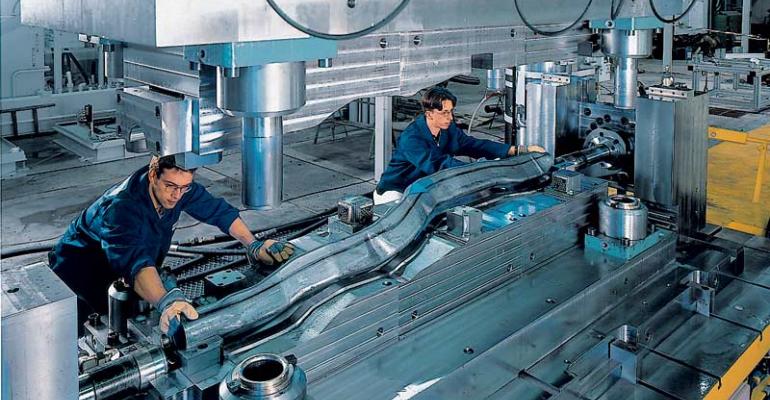CANTON, MI – Auto makers looking to shave every pound out of their vehicles in order to meet looming fuel-economy regulations are increasingly turning to hydroforming, a process that just a few years ago was relegated to niche use.
Tim McCaughey, president and CEO of Schuler, a leading supplier of metal-forming systems and technologies, tells WardsAuto in an interview here, “Today there are (hydroforming) applications for body-in-white in B-pillars and roof applications, where there were none before.
“So that’s immediate growth,” he says. “Whether we’ll find a hydroformed B-pillar in every vehicle line in the future, I doubt it. But every (auto maker) has the opportunity to consider this technology.”
Hydroforming’s origins are in the plumbing industry, where highly pressurized water is injected into pipes to create different shapes. The automotive industry has adapted the process to create intricately shaped molds that in turn are used in producing dies.
Auto makers and Tier 1 suppliers have been experimenting with hydroforming with a variety of materials, including high-strength steels and aluminum. The materials are run through numerous virtual tests to see if their properties are suitable for the process.
Ultra-high-strength steel recently has been added to the mix. Ford, for example, used hydroformed DP 1000, a dual-phase ultra-high-strength steel, for the A- and B-pillars and roof rail for the all-new ’13 Fusion midsize sedan.
By using hydroformed steel tubes for the pillars and rail, the auto maker says it shaved 9.2 lbs. (4.2 kg) off the Fusion body-in-white, leading to improved fuel economy and reduced emissions.
Hydroforming also led to lower development costs for Ford, McCaughey says.
By eliminating the need for multi-piece pillars and rail, the technology allowed Ford to fabricate a single die that can be used anywhere in the world the Fusion, or its Mondeo twin, are built.
Schuler utilizes a process for developing an upgradeable die, eliminating the need for prototype and production dies, further cutting costs. There also is less scrappage than with traditional stamping techniques, which can have low material-utilization rates that inflate project costs.
“We’re finding that with experience and improved software and simulation tools, we’re able to reduce the amount of correction loops in the process and produce many parts with zero scrap,” McCaughey says.
As the lightweighting push continues, auto makers increasingly are turning to Schuler early in the vehicle-development process to determine how best to utilize hydroforming.
While aluminum is considered an up-and-coming material for lightweight techniques, McCaughey says it’s not always the best alternative.
“With one manufacturer, we spent two summers experimenting with different materials, and their tendency was to use aluminum,” he says. “We went with high-strength steel and were able to produce a component that was lighter, with smaller dimensions, but much stronger.”
Looking ahead, Schuler is experimenting with a variety of other materials for hydroforming, including nanosteel, which is as light as aluminum but as strong as high-strength steel.
“We’re in discussions with a couple of different companies on nanosteels to do analysis to see what it’s capable of and what the benefits might be,” McCaughey says.
Schuler, a Tier 2 supplier, currently produces niche components for automotive clients and other industries, but has no plans to ramp up to full-scale volume production. Rather, the company works with auto makers and Tier 1s to develop the dies to the “proof of concept” stage and then hands off the project.
Schuler also offers training sessions for its automotive clients, most recently instructing 200 Ford engineers in hydroforming techniques.
“The auto companies need to look for opportunities,” McCaughey says. “We help them look, but they have to seek out their own applications, so we train them here.”





